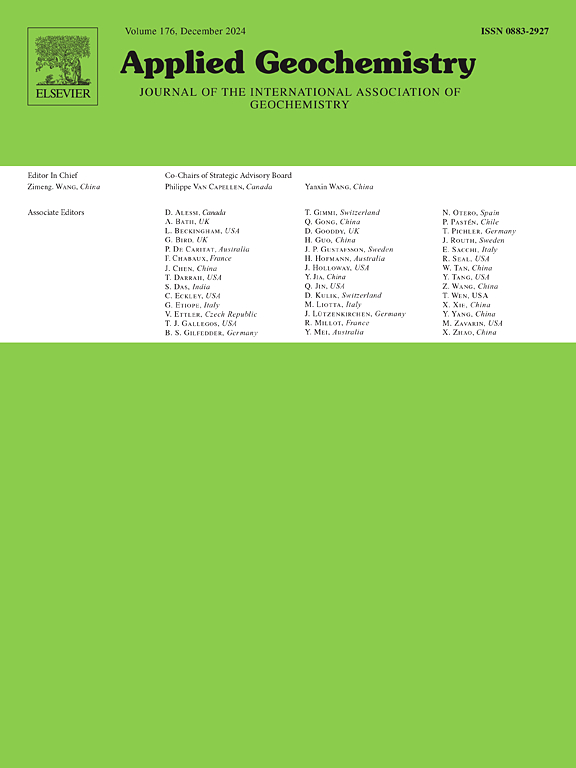Iodine incorporation into calcium phosphate minerals at hydrothermal conditions
IF 3.4
3区 地球科学
Q1 GEOCHEMISTRY & GEOPHYSICS
引用次数: 0
Abstract
Among the numerous radionuclides generated by nuclear fission, radioiodine (129I) poses a long-term environmental and health threat due to its high mobility, solubility, radiotoxicity, and 15.7 Ma half-life. Even though relatively small amounts of radioiodine are generated per ton of spent fuel, its accumulation has exponentially increased since the inception of the nuclear age. Many approaches for the immobilization of radioiodine have been extensively investigated. These methods, however, are still limited by thermodynamic instability, high costs, slow kinetics, and volatile loss during vitrification. Given the relationship and similarities of iodine species with other anions present in apatite, such a mineral still represents a promising host for the safe disposal of radioiodine. However, the interaction between aqueous iodine species and the mineral apatite at hydrothermal conditions remains a knowledge gap. This work evaluated the immobilization of iodate (IO3−) and iodide (I−) from solutions by calcium phosphate minerals (apatite and monetite) at 39 and 200 °C. The performed analysis of our experimental solids encompassed electron microprobe analysis (EMPA), scanning electron microscopy coupled with energy dispersion spectroscopy (SEM-EDS), X-ray diffraction (XRD), and synchrotron X-ray absorption spectroscopy (XAS). In addition, the experimental solutions were analyzed using UV–visible spectrophotometry (UV–Vis) before and after the experiments to track redox changes if any, of the iodine species initially used and to derive iodine concentrations. Iodine concentrations acquired from EMPA (for solids) and UV–Vis (for solutions) were used to calculate the apparent Nernst partition coefficient of iodine as . The highest iodine concentration found in apatite was 6.0 wt% when an iodate-bearing NaCl solution was used as the crystal growth medium. In experiments where iodide-bearing solutions were used, iodine concentrations in apatite ranged from 0.04 to 0.45 wt%. Partitioning data show that IO3− is more compatible with apatite (D > 1) while I− is less compatible (D < 1). The results indicate that iodine incorporation into apatite is favorable at oxidizing conditions.

热液条件下碘与磷酸钙矿物的掺入
在核裂变产生的众多放射性核素中,放射性碘(129I)由于其高迁移率、溶解度、放射性毒性和15.7 Ma的半衰期,对环境和健康构成长期威胁。尽管每吨乏燃料产生的放射性碘相对较少,但自核时代开始以来,其积累量呈指数级增长。许多固定放射性碘的方法已被广泛研究。然而,这些方法仍然受到热力学不稳定性、高成本、慢动力学和玻璃化过程中挥发性损失的限制。鉴于碘与磷灰石中存在的其他阴离子的关系和相似性,这种矿物仍然是安全处置放射性碘的有希望的宿主。然而,在水热条件下,水相碘与矿物磷灰石之间的相互作用仍然是一个知识空白。本研究评估了磷酸钙矿物(磷灰石和铁铁矿)在39°C和200°C下从溶液中固定化碘酸盐(IO3−)和碘化物(I−)。对实验固体进行的分析包括电子探针分析(EMPA)、扫描电子显微镜结合能量色散光谱(SEM-EDS)、x射线衍射(XRD)和同步加速器x射线吸收光谱(XAS)。此外,在实验前后使用紫外可见分光光度法(UV-Vis)对实验溶液进行分析,以跟踪最初使用的碘种的氧化还原变化(如果有的话),并得出碘浓度。用EMPA(固体)和UV-Vis(溶液)测定的碘浓度计算碘的表观能分配系数DI=I(磷灰石)I(流体)。当含碘盐的NaCl溶液作为晶体生长介质时,发现磷灰石中碘的最高浓度为6.0 wt%。在使用含碘溶液的实验中,磷灰石中的碘浓度从0.04到0.45 wt%不等。划分数据表明,IO3−与磷灰石(D >;1)而I−的相容性较差(D <;1). 结果表明,在氧化条件下,磷灰石中碘的掺入是有利的。
本文章由计算机程序翻译,如有差异,请以英文原文为准。
求助全文
约1分钟内获得全文
求助全文
来源期刊

Applied Geochemistry
地学-地球化学与地球物理
CiteScore
6.10
自引率
8.80%
发文量
272
审稿时长
65 days
期刊介绍:
Applied Geochemistry is an international journal devoted to publication of original research papers, rapid research communications and selected review papers in geochemistry and urban geochemistry which have some practical application to an aspect of human endeavour, such as the preservation of the environment, health, waste disposal and the search for resources. Papers on applications of inorganic, organic and isotope geochemistry and geochemical processes are therefore welcome provided they meet the main criterion. Spatial and temporal monitoring case studies are only of interest to our international readership if they present new ideas of broad application.
Topics covered include: (1) Environmental geochemistry (including natural and anthropogenic aspects, and protection and remediation strategies); (2) Hydrogeochemistry (surface and groundwater); (3) Medical (urban) geochemistry; (4) The search for energy resources (in particular unconventional oil and gas or emerging metal resources); (5) Energy exploitation (in particular geothermal energy and CCS); (6) Upgrading of energy and mineral resources where there is a direct geochemical application; and (7) Waste disposal, including nuclear waste disposal.
 求助内容:
求助内容: 应助结果提醒方式:
应助结果提醒方式:


